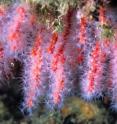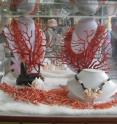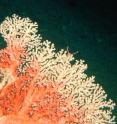SeaWeb applauds US decision to support bluefin tuna trade protection
Related images
(click to enlarge)
SeaWeb applauded the announcement by the United States that it will support a proposed international trade ban for endangered bluefin tuna, and the ocean conservation organization called for international support for 32 species of red and pink coral as well as for eight shark species proposed for similar protection. These unique and valued marine species will be the focus of the upcoming Convention on International Trade in Endangered Species (CITES) Conference of Parties (CoP15), in Doha, Qatar, March 13 to 25. SeaWeb's Too Precious To Wear campaign raises awareness of the threats posed to coral by the international trade. Red and pink coral (scientific name: Coralliidae) are widely used in jewelry and home décor but are among the least protected of all coral species.
"SeaWeb applauds the United States for its strong support of trade protection for bluefin tuna, and for its leadership in proposing six species of sharks and red and pink coral for CITES protection," said Kristian Teleki, who is SeaWeb's vice president for science initiatives and based in London. "The Doha meeting represents a unique opportunity for meaningful trade measures to be put in place for these valuable marine species."
Scientists, conservationists, jewelers and designers are urging countries to protect red and pink corals, calling the Qatar meeting the last chance for these long-lived, slow-growing species to receive international trade protection. Red and pink coral are a type of deep-sea precious coral found in the Mediterranean and Pacific. Between 30 and 50 metric tons of these corals are taken from the ocean annually to meet consumer demand for jewelry and decorative items. The United States alone imported 28 million pieces of red and pink coral between 2001 and 2008. A finished red coral necklace can retail for hundreds of thousands of dollars. Jewelry retailer Tiffany & Co., designer Temple St. Clair, ocean conservationist Céline Cousteau and many others are in support of the United States and European Union's proposal to protect red and pink coral under Appendix II of CITES.
"Overfishing of red and pink coral has put these animals—precious jewels of the sea—at great risk," said Teleki. "A CITES Appendix II listing for Coralliidae can help safeguard these species as well as the future of the industries and people that depend on them."
The global wildlife trade is immense, highly valuable and is often a threat to global conservation efforts. Thousands of species are traded every year, with an estimated value of US$160 billion. Illegal trade in wildlife products is estimated at US$10 to US$20 billion. Scientists estimate that because of trade, loss of habitat and other environmental changes, species are becoming extinct 1,000 times faster than a natural rate. The United Nations has declared 2010 the International Year of Biodiversity, and protection for many species under CITES is needed to protect diversity, livelihoods and ecosystems around the world.




